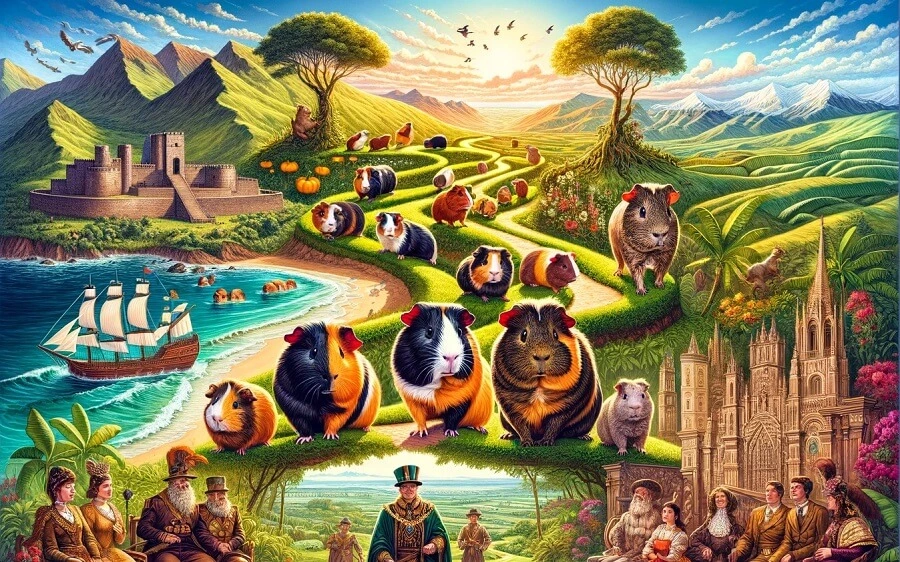Guinea pigs have captivated hearts worldwide, but their journey to our homes is a story woven through time and across continents. These charming creatures originate from the lush landscapes of the Andes. They have been companions, symbols of cultural significance, and even pioneers in scientific discoveries.
Their evolution from a revered resource in ancient civilizations to beloved household pets in modern societies is a testament to their adaptability and enduring appeal.
This article embarks on a journey through time. It traces the fascinating history of guinea pigs and explores how these small creatures earned such a big place in human hearts. From ancient rituals to modern-day celebrations, let’s unravel the tale of guinea pigs – from the Andes to our homes.
Ancient Roots in the Andes
Guinea pigs, or “cavies,” have their earliest known origins in the Andean region of South America. They were not just animals, but a central part of life.
Domesticated as early as 5000 BC, they were integral to the daily lives and spiritual practices of Andean civilizations such as the Incas, Moche, and Chimu. These civilizations revered guinea pigs not only as a sustainable food source. They also revered them for their role in traditional medicine and religious ceremonies.
The guinea pig’s depiction in art and artifacts indicates their prominence; they were often portrayed in intricate pottery and textiles, symbolizing fertility and prosperity.
The relationship between the Andean people and guinea pigs was deeply symbiotic. These small creatures thrived in close quarters with humans, adapting well to the mountainous environment. Their breeding was a meticulous practice, reflecting the community’s respect and dependence on them.
Guinea pigs were often involved in healing rituals. People believed that animals could diagnose diseases. Shamans interpreted their movements to predict outcomes.
Their significance was so profound that they were considered gifts from the gods, playing a part in major life events, from birth celebrations to funeral rites.
Related Article: Guinea Pig Care Guide: Must-Knows for New Owners
Across the Oceans: Guinea Pigs in Europe
The voyage of guinea pigs from the Andes to Europe is a tale of curiosity and wonder. Spanish, Dutch, and English traders, enchanted by these novel creatures during their South American explorations, brought them across the oceans in the 16th century.
Initially, guinea pigs graced the European lands as exotic gifts, intriguing the upper class and royalty. Queen Elizabeth I herself was known to have kept a guinea pig, elevating their status as pets of novelty and luxury.
In these early days in Europe, guinea pigs were more than mere pets; they were symbols of wealth and status. Their exotic origin and unique appearance captivated many, making them prized possessions among the aristocracy. They were often showcased in paintings, reflecting their esteemed position in society.
However, their purpose wasn’t solely ornamental. Their curious nature and ease of breeding made them subjects of early scientific inquiry and observation. Scholars and naturalists were keen to study their behavior and physiology, laying the groundwork for their later role in scientific research.
This period marked the beginning of a broader fascination with guinea pigs, extending beyond the confines of the elite. As breeding became more common, these creatures gradually transitioned from the exotic to the familiar, paving the way for their eventual role as cherished household companions.
The Shift to Beloved Pets
The transformation of guinea pigs from exotic novelties to beloved pets unfolded over centuries, as they gradually wove their way into the fabric of family life. This shift was propelled by their endearing nature and the ease of caring for them.
By the 19th century, guinea pigs had begun to captivate the hearts of the middle class, transitioning from the exclusive circles of the aristocracy to becoming cherished members of many households.
The allure of guinea pigs lay not just in their gentle demeanor but also in their practicality. They required minimal space, making them ideal for both rural and urban dwellings. Their prolific breeding and hardy nature suited the lifestyle of many families, offering companionship without the extensive demands of larger pets.
During the Victorian era, guinea pigs surged in popularity. People held guinea pig shows and competitions for fun, solidifying their status as beloved pets. Children, in particular, found joy and companionship in these furry friends.
The educational aspect of caring for guinea pigs, understanding their needs, and observing their social behavior, provided valuable lessons in responsibility and empathy. As these small creatures scurried their way into family dynamics, they also promoted a sense of togetherness, with guinea pig care becoming a shared family activity.
Scientific Pioneers: Guinea Pigs in Research
Parallel to their rise as household pets, guinea pigs earned a distinguished place in the annals of scientific research. Their contributions to medicine and science are profound, with their physiological and genetic similarities to humans making them invaluable in pioneering studies. From the 17th century onwards, guinea pigs have been instrumental in breakthroughs that have shaped modern medicine.
One of the most notable contributions of guinea pigs to science was in the study of infectious diseases and the immune system. Their susceptibility to various pathogens made them ideal subjects for studying disease mechanisms and testing medical treatments.
The discovery of Vitamin C and its role in preventing scurvy was a landmark achievement, with guinea pigs playing a crucial role due to their unique need for dietary Vitamin C, mirroring humans.
Guinea pigs also contributed significantly to the field of allergy and asthma research. Their respiratory system’s response to allergens provided crucial insights into human respiratory conditions, leading to improved treatments and understanding of these ailments.
Moreover, their role in the development of vaccines, including the diphtheria and tuberculosis vaccines, has been invaluable. It has saved countless lives and advanced public health.
While their use in research has raised ethical considerations, the contributions of guinea pigs to scientific advancement cannot be understated. Their role in research has diminished with the advent of other models and ethical guidelines. Yet, their historical contributions continue to benefit humanity.
Diversity in Breeds: A Spectrum of Choices
As guinea pigs became more entrenched in society, a fascinating variety of breeds emerged. Each has distinct characteristics and charm. Breeders, driven by passion and curiosity, began experimenting with coat types, colors, and patterns, leading to the rich diversity we see today.
From the sleek, short-haired American guinea pig to the luxurious, flowing locks of the Peruvian, the spectrum of guinea pig breeds is a testament to human creativity and affection for these animals. Each breed offers a unique combination of traits, catering to the preferences of different owners.
The Abyssinian, known for its rosette-patterned fur and spirited personality, contrasts with the serene and silky-soft Sheltie. The Teddy, with its dense, plush coat resembling a soft toy, provides a different tactile experience compared to the exotic, rough-textured Rex.
This diversity not only adds to the aesthetic appeal of guinea pigs but also allows potential owners to choose a pet that resonates with their lifestyle and preferences.
The emergence of these breeds has also spurred a community of enthusiasts and breeders. It has fostered a culture of sharing, learning, and camaraderie.
Guinea pig shows and competitions celebrate the beauty and uniqueness of each breed. They promote high standards of care and breeding practices. This vibrant community ensures the well-being of guinea pigs, while continually enriching the breed diversity that makes these pets so endearing.
Cultural Reverence and Modern Celebrations
Guinea pigs hold a unique place in cultural traditions and modern celebrations, reflecting their enduring significance across the globe. In some Andean regions, they are still revered, playing a central role in traditional rituals and feasts.
The annual festival of ‘jaca tsariy‘ (collecting the guinea pigs) in Peru is a testament to their lasting cultural importance, where these creatures are celebrated and blessed.
In contemporary times, guinea pigs are celebrated through various events and online communities. This showcases the love and admiration people have for them. Social media platforms are filled with guinea pig appreciation groups. Owners share tips, stories, and adorable pictures.
This further solidifies the global community of guinea pig enthusiasts. These platforms not only celebrate the joy guinea pigs bring into our lives but also serve as vital resources for responsible pet care and adoption, ensuring these cherished creatures receive the love and respect they deserve.
Conclusion: A Timeless Companion
The guinea pig’s journey from the Andean highlands to our homes is a story full of history, cultural importance, and affection. These small, gentle creatures have traveled across continents and centuries.
They’ve become beloved members of families worldwide. Their transformation from a revered resource in ancient civilizations to cherished companions today reflects their adaptability. It also shows the special place they hold in human hearts.
The diversity of breeds, their role in scientific advancements, and their continued cultural relevance underscore their multifaceted significance. As we celebrate the history and the charm of these endearing animals, it’s clear that guinea pigs are more than just pets – they are timeless companions, continuing to enrich our lives with joy, companionship, and love.

